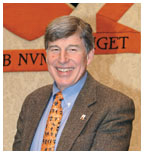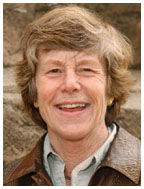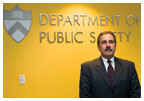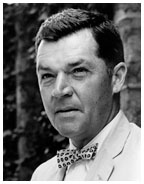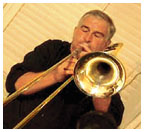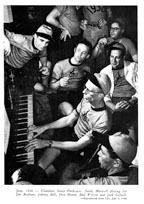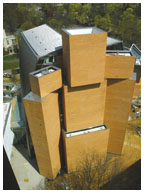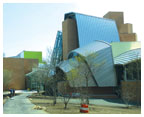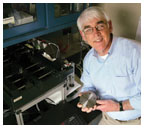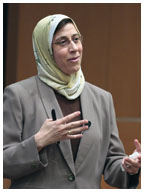
|
May 14, 2008: Notebook
$25 million gift to strengthen engineering-liberal arts ties
Campus police seek approval to carry weapons
Hundreds attend memorial service for Goheen
The sounds of Reunions
From jazz to rock, music provides the beat
The latest on campus construction
BREAKING GROUND - chemical engineering
$25
million gift to strengthen engineering-liberal arts ties
Donors
recognized with renamed Keller Center
Dennis Keller ’63 at Alumni Day 2008
Connie Keller (photos: (top) T. Kevin Birch, courtesy department of annual giving, (inset) courtesy Dennis ’63 and Connie Keller) |
In 2000, Engineering Dean H. Vincent Poor *77, then a professor of electrical engineering, debuted “The Wireless Revolution,” a course that examined the societal impact of advances in wireless technology as well as the technologies themselves. It soon became one of the University’s most popular classes, drawing more than 500 students in its first three semesters, including scores of non-engineers.
It was the 250th Anniversary Fund that spurred Poor to create the course, he said, referring to an initiative that provided funding for classes like his. “The idea was there, but if it hadn’t been for those resources, I might have said, ‘Oh, I’ll do it next year,’” Poor said.
For the last two years, Princeton’s Center for Innovation in Engineering Education has tried to provide the same type of encouraging nudge for faculty pursuing new ideas in engineering classrooms. On April 7, the center received a major boost: a $25 million gift from Dennis Keller ’63, the founding chairman of DeVry Inc., and his wife, Connie, aimed at improving the links between engineering and the liberal arts at Princeton.
The newly named Keller Center for Innovation in Engineering Education supports courses, internships, engineering community-service groups, and programs that promote leadership and entrepreneurship. With the Kellers’ gift, Poor said, the center “will greatly expand” those offerings. In the short term, the gift will add resources to existing classes like the school’s integrated engineering, math, and physics course for freshmen. Long-term priorities include more opportunities for non-engineers to increase their technological literacy. About 60 percent of non-majors take at least one engineering class, and Poor aims to bring that figure closer to 100 percent by adding to the list of engineering courses open to A.B. students (currently, there are about 20).
The center will continue to host visiting faculty members whose work relates to student interests. Next year, Engineers Without Borders founder Bernard Amadei is expected be named the Kenan Trust Visiting Professor. Princeton’s student-run Engineers Without Borders chapter has about 50 active members and ongoing service projects in Ethiopia, Ghana, and Peru.
The educational initiatives at the Keller Center grew from what former Dean Maria Klawe dubbed “engineering for a better world” in 2004, at the end of a year-long strategic planning process for the engineering school. Two of the primary architects of that vision have left Princeton: Klawe is now president of Harvey Mudd College, and associate dean T. Kyle Vanderlick became Yale’s dean of engineering in January. But the concept remains in place, according to Poor.
The “better world” idea has influenced the engineering school’s research priorities. Poor said that faculty are focusing on four “areas of societal need”: energy, environment, health, and security. Each is broadly defined. Security, for instance, includes traditional work in national defense as well as newer research topics like secure information technology and electronic voting.
“Engineering has always been about doing useful things for society,”
he said. “[‘Engineering for a better world’] is, in
some ways, a reaffirmation of that aspect of the field.” ![]()
By B.T.

FOP president Jim Lanzi: “Part of the police officer’s role is to carry a weapon.” (Hyunseok Shim ’08 ) |
Campus police seek approval to carry weapons
The University’s Fraternal Order of Police (FOP) union wants sworn officers to be allowed to carry guns on campus. Princeton administrators say they see no need to switch to an armed campus police force, however.
“This policy is based on our recognition that our main campus is located in two communities with rather sizable police forces that are readily accessible,” said Princeton spokeswoman Cass Cliatt ’96. “We are also concerned that the level of trust and rapport between Public Safety and students could really be diminished.”
But FOP President Jim Lanzi, the University’s crime-prevention coordinator, contends that Princeton needs to reconsider its stance. “Part of the police officer’s role is to carry a weapon, and the purpose of that is to be able to respond,” said Lanzi. “We see it as a tool that is necessary to perform our task. If we don’t have the ability to protect ourselves, we can’t protect the community.”
Campus police could respond faster to a critical incident simply by virtue of their proximity and familiarity with campus, Lanzi said, rather than waiting for local law enforcement to be called in.
Some Princeton students share these concerns. “Could you imagine a borough officer trying to find McCosh 10 or the B-6-N area of Firestone Library?” said Michael Westrol ’06, creator of the 160-member Facebook group Princetonians for a Safer Campus. “They’re rolling the dice and hoping that nothing will happen.”
The issue has gained additional momentum since last year’s shooting spree that claimed 33 lives at Virginia Tech. Two days after the first anniversary of the massacre, the International Association of Campus Law Enforcement Administrators unveiled its Blueprint for Safer Campuses during an April 11 conference at Princeton. Among its recommendations: “Sworn officers should be armed.”
Lanzi said the FOP is pressing for a change that would limit the carrying of firearms to about 22 sworn officers at the University, and not to the more widespread general-security officers.
The president of the New Jersey College & University Public Safety Association, Glenn Miller, supported the FOP’s request. “To ask a police officer to respond to a dangerous situation without the appropriate tools is like asking a professor to teach without the proper books or resources,” Miller said.
On the national level, colleges have demonstrated growing interest in
shifting their forces from the traditional role of crime prevention to
armed law enforcement. U.S. Bureau of Justice statistics show that among
four-year colleges and universities with at least 2,500 students, two-thirds
had armed campus police officers in 2004–05. ![]()
By Alice Lloyd George ’09

Robert F. Goheen ’40 *48 (Ulli Steltzer) |
Hundreds attend memorial service for Goheen
To the measured words of Scripture, the ancient wisdom of Sophocles, and the strains of Duke Ellington, the University community remembered the life of Princeton’s 16th president, Robert F. Goheen ’40 *48, during a service April 27 in the University Chapel. President Shirley Tilghman, former president William G. Bowen *58, and other University officials past and present were among the hundreds of people in attendance. Goheen died March 31 at the University Medical Center at the age of 88.
Goheen had planned much of his memorial service several years ago, sending his ideas to his children in a letter marked “Someday.” They included the 23rd Psalm, the Prayer of St. Francis, and the Prayer for Princeton, along with two hymns. A lover of jazz, Goheen asked that the prelude to the service be Ellington’s “It’s Freedom,” performed by the Chapel Choir. His longtime friend, James I. Armstrong ’41 *49, read an ode from Antigone.
Bowen delivered words of remembrance. Goheen, he said, “would not have wanted to be remembered for ... buildings built and dollars raised. His most lasting contribution was, without question, the values, the spirit, he infused into Princeton during his 70 years of association with the University.” Bowen in particular paid tribute to Goheen’s foresight in leading Princeton toward a more racially diverse student body and to his open-mindedness, which led him to change his opinion and embrace coeducation.
Before the postlude — recorded selections from Benny Carter’s Harlem Renaissance — and after a quick consultation with the Goheen family, former dean of the chapel Frederick Borsch ’57 announced an impromptu change in the program: the singing of “Old Nassau.”
For all the words delivered from the pulpit, the remembrance that Goheen
would have appreciated most may have come from one of the pews. An African-American
woman from the Class of 1975 introduced herself to an alumnus from the
late ’50s. Although Goheen had retired before she graduated, the
woman remarked simply, “I wouldn’t be here without him.”
![]()
By M.F.B.
MORE ONLINE, click here: Read and submit reminiscences of Robert F. Goheen ’40 *48

Bill Webster ’73 is recruiting alumni musicians for a May 30 Battle of the Bands. (Courtesy Bill Webster ’73)
Sandy Maxwell ’39 plays piano for classmates Jim Benham, Johnny Bell, Don Heard, Bud Wilson, and Jack Gefaell at Reunions 1946. (Allan Grant/Life Magazine) |
The
sounds of Reunions
From jazz to rock, music provides the beat
For its 50th reunion, the Class of 1958 is bringing New Orleans to New Jersey, hosting about 70 New Orleanian musicians from six bands for what reunion co-chairman David Greenberg ’58 calls “a show the likes of which Princeton has never seen.”
The idea has been in the works since the months following Hurricane Katrina, when Greenberg, who lives in New Orleans, began thinking of ways that his class might lend a hand to the city’s struggling musicians. He started looking for bands that managed to stay together after the storm and asked them if they might be able to clear a weekend in late May of 2008.
The bands that signed on cover a range of styles, from the turn-of-the-century jazz of the New Leviathan Oriental Fox-Trot Orchestra to the early rock ’n’ roll of the Severins Band. Others playing at the ’58 tent include Loose Marbles, a popular group of young street musicians that frequently sets up shop on Royal Street in the French Quarter, and the Treme Brass Band, which will lead a traditional jazz funeral procession from the University Chapel after the class’s memorial service.
Class members also will host a May 31 forum called “New Orleans: What’s Past Is Prologue,” in which musicians will share their stories, interact with alumni, and play a few tunes. The program, open to all reuners, will begin at 10:30 a.m. in the 50th-reunion headquarters (Blair-Campbell-Joline Courtyard).
“It’s a chance to get to know [the musicians] as artists and as people,” Greenberg said. “They’ve been through hell, and it’s not over down there.”
Bill Webster ’73 and his band, Webster’s Unabridged, got hooked on Reunions as students and kept coming back for gigs after graduation, bringing their rock ’n’ roll tunes to Princeton for 10 straight years. But each time, Webster said, “it got harder and harder to pull the band back together.” Eventually, the streak was, well, abridged.
This year, as organizer of the first Alumni Battle of the Bands, Webster is making it easier for alumni bands to reunite. He’s providing instruments and sound equipment for all musicians, and he also has arranged to have professionals in reserve for bands that might be missing a drummer, bassist, or keyboardist. Webster hopes to have at least five bands on the bill, including undergraduates. The show will begin at 1 p.m. May 30 on the Frist Campus Center’s South Lawn. (Interested groups can contact Webster at 310-245-5942.)
Webster’s Unabridged plans to be among those returning to the stage, and if this year goes well, the Battle of the Bands could become an annual event. But don’t be fooled by the name: Webster insisted it will be a laid-back affair. “If you want to do one or two songs, that’s cool,” he said. “If you want to do a whole set, that’s good, too. We’re wingin’ it.”
At Reunions in the 1950s, nearly every tent had its own jazz band. Tom Artin ’60 *68, a professional trombonist and the son of a Princeton math professor, remembers listening to some of New York’s top groups and the clusters of talented alumni who played along. “Growing up in town as a jazz nerd, as I was, it was paradise,” he said.
If that jazz paradise had elected a mayor, pianist Sandy Maxwell ’39 would have been the leading candidate. The lifelong Princeton resident was an undergraduate during the University’s golden age of jazz, when he wrote tunes for the Triangle Club. He later forged friendships with young jazz musicians in the 1950s, arranging jam sessions in town with friend and fellow musician Doug MacNamee ’32. And for more than six decades, Maxwell entertained audiences at Reunions, providing a common thread in Princeton’s jazz history.
“He was Mr. Princeton, as far as jazz was concerned,” said Ed Polcer ’58, a Brooklyn-based cornetist. “Sandy represented a real continuity of this type of music being played at Reunions.”
Maxwell died in February, two months after celebrating his 90th birthday.
He had played Reunions gigs to the end, including a concert at the Class
of 1942’s 65th last year. At his memorial service, members of Maxwell’s
band said goodbye with their rendition of “Memories of You,”
the classic Eubie Blake tune — a fitting tribute for the man who
filled Reunions tents with the sounds of the Great American Songbook.
![]()
By B.T.

Reunions
highlights
President Tilghman will hold her annual conversation with alumni Saturday,
May 31, at 10:30 a.m. in Richardson Auditorium, and the P-rade will step
off at 2 p.m. The University Orchestra will begin its concert at Finney
and Campbell fields at 8 p.m., followed by the fireworks show at 9:15
p.m.
On Friday, May 30, at 1:30 p.m., PAW will host its first Reunions panel discussion, “PAW-litics 101,” in the Frist Campus Center’s air-conditioned Film/ Performance Theater (room 301). The event will provide an insider’s look at the 2008 presidential campaign from alumni journalists Jim Kelly ’76, managing editor of Time Inc.; Kathy Kiely ’77, a reporter for USA Today; moderator Joel Achenbach ’82 of The Washington Post; Todd Purdum ’82, national editor at Vanity Fair; Juliet Eilperin ’92, a reporter at The Washington Post; Rick Klein ’98, senior political reporter for ABC News; and Andrew Romano ’04, an associate editor at Newsweek.
For a complete schedule of Reunions events, visit the Alumni Association’s
Web site at http://alumni.princeton.edu/main/goinback/reunions/.
![]()

Lewis Science Library
Lewis Science Library
Butler College
Department of Operations Research and Financial Engineering (Photos: Frank Wojciechowski) |
The latest on campus construction
While Whitman College, the single largest construction project in Univer-sity history, opened last fall, work continues on several major campus projects. Two are nearing completion, while Princeton’s third four-year residential college is on track to open in the fall of 2009. Here’s an update:
Work is nearly complete on the Lewis Science Library, designed by celebrated architect Frank Gehry. The 87,000-square-foot building, located on the corner of Washington Road and Ivy Lane, should be fully operational in the fall, with some offices moving in during the summer. The library will house the astrophysics, biology, chemistry, geosciences, math, physics, and statistics collections, as well as the map collection and the Digital Map and Geospatial Information Center. The building also will house the Education Technologies Center, the New Media Center, the Princeton Institute for Computational Science and Engineering, and a new broadcast center. Peter B. Lewis ’55 donated
$60 million toward the building; University treasurer’s reports have put the total cost at $74 million.
Extensive work is under way on the new dorms of Butler College, located across Elm Drive from Whitman College and on the site of the razed New New Quad. The Butler complex, scheduled for occupancy in September 2009, will become Princeton’s third four-year residential college. The new red-brick dorms with limestone trim will house 290 students, primarily in quads and doubles. The University treasurer’s report lists the cost of the 112,000-square-foot Butler project at $88 million.
Installation of glass facing is nearly finished on a new building to
house the Department of Operations Research and Financial Engineering,
the engineering school’s largest department. The building, located
between Wallace Hall and Mudd Library and across from the computer science
building, should be ready for use in August. The 46,000-square-foot building
also will be home to the Center for Information Technology Policy and
will include some general classroom space. ![]()

Professor Robert Prud’homme is working on nanoparticle drug delivery to fight cancerous tumors. Frank Wojciechowski |
BREAKING GROUND - Chemical Engineering
Delivering life-saving drugs
With diameters measured in billionths of a meter, nanoparticles are almost too small to imagine. For example, think of a particle 300 nanometers wide. About 300 such particles, placed side by side, would span the width of one human hair. Now consider an application for which a 300-nanometer particle is simply too large. That is the problem chemical engineering professor Robert Prud’homme faces in one project that aims to efficiently deliver drugs to cancerous tumors.
Prud’homme’s collaborators at Celator, a pharmaceutical firm with labs a few miles from campus, have found that solid tumors are good candidates for nanoparticle drug delivery because their rapid growth rate causes defects in the capillaries that bring blood to the tumor. Particles 100 to 200 nanometers in size can leak through those defects in the capillary walls and embed themselves in a tumor to deliver chemotherapy drugs.
Larger particles would not be able to fit through the tiny leaks in a tumor’s blood vessels, but nanoparticles smaller than 50 nanometers also could be ineffective — and dangerous — because they might deliver toxic drugs throughout the body, not just to tumors.
Additionally, Prud’homme says, “You need really precise control of the particle’s surface chemistry, because you want something that circulates a long time and goes through the cancer tumor many times.” Prud’homme, an expert on the assembly of polymers (large molecules composed of long chains of smaller molecules), has worked with Celator to develop 100- to 200-nanometer particles with a dense, protective outer layer that makes them invisible to the body’s immune system. In studies on laboratory rats, the particles circulated in the body for 18 hours, a marked improvement over the one-hour circulating time for other nanoparticles developed for the same applications.
Prud’homme says his students seem to like the medical applications because they provide opportunities for a “tangible impact on human needs.” One particularly timely project in his lab involves developing a new treatment for tuberculosis, a deadly disease in the developing world, particularly among AIDS patients in Africa. The work, sponsored by the Bill and Melinda Gates Foundation and led by Harvard professor David Edwards, aims to deliver drugs in an inexpensive, easily administered aerosol inhaler, using composite particles of sugar and drug-loaded nanoparticles, to replace the more expensive IV injections required today.
Nanoparticles carry great promise, from drug delivery to improved imaging technologies, but they also present challenges that often require expertise in chemistry, physics, and engineering. Prud’homme has found collaborators in each area, including Princeton colleagues Jamie Link, Doug Adamson, Winston Soboyejo, Robert Austin, Jeffrey Schwartz, and Yiguang Ju.
“We all get together and do things that none of us could do independently,”
he says. “It’s a fun, extended family of people who have to
come together to make this work.” ![]()
By B.T.

Amaney Jamal (Woongcheol Yang ’10) |
“The Muslim-American population is pretty much for integration [with non-Muslims], except that a quarter say that they want to be Muslim first, and we can attribute that to another dimension: U.S. foreign policy. What America stands for in the world doesn’t resonate well with the Muslim community.”
Amaney Jamal, assistant professor of politics, speaking April 22 in
Robertson Hall on “Muslim Americans: Enriching or Threatening American
Democracy?” ![]()

Three alumni were among the winners of PULITZER PRIZES last month. John Matteson ’83, an associate professor of English at John Jay College of Criminal Justice, won the biography prize for his first book, Eden’s Outcasts: The Story of Louisa May Alcott and Her Father. Barton Gellman ’82 of The Washington Post and a colleague at the Post, Jo Becker, won the national-reporting award for their examination of Vice President Dick Cheney’s influence. Ian Shapira ’00 shared the breaking-news award with other Post staffers for coverage of the shootings at Virginia Tech.
The PRINCETON DEBATE PANEL last month received the first College of the Year award, presented at the American Parliamentary Debating Association's national championships at MIT. The team attended more than 20 tournaments this year, including the North American championship in Ottawa and the world championship in Thailand; the College of the Year award recognized the panel’s success over the debate season.
JOHN PRENDERGAST, co-founder of the ENOUGH initiative to end genocide, was presented by undergraduates with the Crystal Tiger Award April 21. Prendergast has been involved in numerous peace missions throughout Africa and has written eight books about the continent. The most recent is Not on Our Watch: The Mission to End Genocide in Darfur and Beyond, which was co-written with actor Don Cheadle, star of the film Hotel Rwanda. In a talk in McCosh 50, Prendergast challenged students “to get others involved.” The award is presented each year by students to a person “who has had a transformative impact on their lives.”
RON McCOY *80, the university architect at Arizona State University since 2003, has been named Princeton’s new University architect. He succeeds Jon Hlafter ’61 *63, who retired in March. “One has to be very humble to assume this position in his footsteps,” McCoy said. McCoy, who has a master’s degree in architecture from Princeton, was the project architect for the Lewis Thomas Laboratory while working with Venturi, Scott Brown and Associates. He joined the Arizona State faculty in 1995.
The University has been named in a lawsuit filed by a Princeton senior
who said she was sexually assaulted at TIGER INN on the
night of bicker pickups in February 2006. Among the defendants named in
the suit are Tiger Inn, the club’s graduate board, current and former
officers of the club, and a male member of the Class of 2007 who is accused
of the assault. The Trenton Times reported that the Mercer County
prosecutor’s office had investigated the incident and that no criminal
charges were filed. Craig Hubert, the lawyer for the plaintiff, told
The Daily Princetonian that the University had failed to take action against
the club despite knowing that dangerous behavior previously had taken
place there, failed to provide proper safety measures, and allowed the
club to recruit in the dorms and to use the Princeton e-mail system. University
spokeswoman Cass Cliatt ’96 said it was “premature”
to respond to the lawsuit. ![]()

JOHN A. WHEELER, one of the 20th century’s leading
theoretical physicists and a member of the faculty from 1938 to 1976,
died April 13 at his home in Hightstown, N.J. He was 96. Interested in
the overarching questions in physics throughout his career, Wheeler was
a major figure in the development of the atomic and hydrogen bombs and
later was regarded as the father of modern general relativity. He gave
black holes their name and, as a teacher, helped inspire the careers of
many prominent theoretical physicists. ![]()

